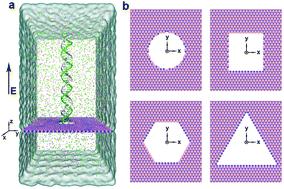Computational investigation of geometrical effects in 2D boron nitride nanopores for DNA detection†
Abstract
Nanopore-based DNA detection and analysis have been intensively pursued theoretically and experimentally over the past decade. Owing to their nanometer thickness, 2D nanopores, such as boron nitride nanopores, show great potential for achieving DNA detection at base resolution. Although 2D nanopore devices hold great promise for next-generation DNA detection, efficiently and reliably detecting different DNA sequences is still a challenging problem. To date, most of the investigated nanopores adopt circular shapes. Because of the successful fabrication of triangular nanopores, investigating the shape effect of nanopores for DNA detection has become more and more important. In this study, boron nitride nanopores with circular, hexagonal, quadrangular and triangular shapes were modeled at various sizes. The translocation of homogeneous dsDNA through these nanopores was investigated by all-atom molecular dynamic simulations. The ionic conductivity of these nanopores was characterized and formulas for the total resistance based on the pore and access resistance were derived. The ionic current, dwell time and conductance blockade of homogeneous dsDNA were compared for nanopores with different shapes. We demonstrate that the charge distribution at the pore mouth plays an important role in the transportation of ions and DNA molecules. Our findings may shed light on the design of 2D nanopores and can facilitate the development of fast, low-cost and reliable nanopore-based DNA detection.

- This article is part of the themed collection: Theoretical Modelling at Nano-bio Interfaces


 Please wait while we load your content...
Please wait while we load your content...